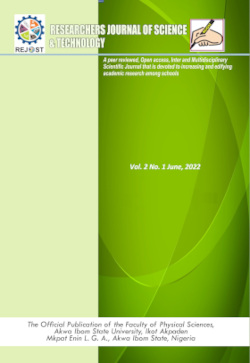Assessment of Contamination Status of Heavy Metals in Sediment due to Gas Flaring at Esit Eket, South Eastern Nigeria
Keywords:
Gas flare, Bioaccumulation, Intertidal, Enrichment factor (Ef), geo-accumulation index (Igeo), contamination factor (Cf), VegetationAbstract
This study assessed the contamination status of heavy metals in sediment of Esit Eket, south eastern Nigeria due to gas flaring. Six sediment samples were collected into well labeled polyethene bags with the use of a hand trowel at a depth of 10cm during the dry season in the month of February precisely in the intertidal zone at extremely low tide randomly from the flare point to a distance of about 250m away from the flare site. These samples were refrigerated for two days before transported to the laboratory to analyze for heavy metals concentration using a particle induced x-ray emission (PIXE) technique. Heavy metals such as Titanium (Ti), Chromium (Cr), Manganese (Mn), Iron (Fe), Copper (Cu), Zinc (Zn), Rubidium ( Zirconium (Zr) and Lead (Pb) were Rb), Strontium (Sr),analyzed.The meanconcentration values of these metals were4739.73, 83.94, 1782.28, 37519.54, 24.36, 134.68, 56.33, 112.80, 118.60 and 31.85 ppm respectively. The three pollution indices {enrichment factor (EF), geo-accumulation index (Igeo) and contamination factor (CF)} employed to assess the contamination status of heavy metals in sediment samples of the study area revealed the elemental trend to be in descending order in each area of this study Mn>Zn>Pb>Cu>Fe>Sr>Rb>Cr>Ti> Zr. Analysis of multi-variate statistics such as Pearson’s Correlation coefficient and cluster analysis were also applied to ascertain the relationship and sources of investigated heavy metals. Both positive and negative correlations were observed among some heavy metals but at 0.05 levels, while the cluster analysis revealed three main clusters. The study concluded that the ecosystems in the flared sites region are vulnerable to bioaccumulation of heavy metals in the soil. The concentrations of Iron (Fe) in sediments are higher at the study area than every other elements but Manganese (Mn) poses more negative effects than others.
References
Abdulkareem, A. S. 2005. Evaluation of ground level concentration of pollutant due to gas flaring by computer simulation: A case study of Niger - Delta area of Nigeria. Leonardo Electronic Journal of Practices and Technologies. 6: 29 - 42.
Aghalino, S. O. 2009. Gas flaring, environmental pollution and abatement measures in Nigeria, 1969 – 2001. Journal of Sustainable Development in Africa. 11(4): 219 – 38.
Agrawal, M.L, Dikshit, A.K. 2002. Significance of Spatial Data and GIS for Environmental Impact Assessment of Highway Projects. Indian Cartographer. MUIP 04: 262-266.
Akinro, A. O., Opeyemi, D. A. and Ologunagba, I. B. 2008. Climate change and environmental degradation in the Niger Delta region of Nigeria: Its vulnerability, impacts and possible mitigations. Research Journal of Applied Sciences. 3(3): 167 – 173.
Akpan, I. O., Thompson, E. A. 2013. Assessment of Heavy Metal Contamination Andersen, G. L. 2006. How to detect desert trees using CORONA images: Discovering historical ecological data. Journal of Arid Environments. 65: 491–511.
Banko, G. 1998. A review of assessing the accuracy of classifications of remotely sensed data and of methods including remote sensing data in forest inventory. International Institution for Applied Systems Analysis, Laxenburg, Austria. IR-98-081.
Bayram, B., Bayraktar, H., Helvaci, C. and Acar, U. (2004). Coast line change detection using CORONA, SPOT and IRS 1D images. Proceedings of the 20th Congress of I.S.P.R.S. Istanbul, Commission. 7(3): 437-441.
Birch, G., 2003. A scheme for assessing human impacts on coastal aquatic environments using sediment source.
Dung, J. E., Bombom, S. L. and Agusomu, D. T. 2008. The effects of gas flaring on crops in the Niger Delta, Nigeria. GeoJournal. 73: 297–305.
Eaton, A.D. and Franson, A. H., 2015. Standard Methods for the Examination of Water and Waste Water, American Public Health Association
Edino, M. O., Nsofor, G. N. and Bombom, S. L. 2010. Perceptions and attitudes towards gas flaring in the Niger Delta, Nigeria. Environmentalist. 30: 67–75.
Ekanim, M. P and Udoessien E. I., (2013). Air Quality Studies of Eket Zone of Niger Delta region of Nigeria. Journal of Afr. J. Environ. Pollut. Health 10:20-25.
Eugenio, F. 2003. Automatic satellite image georeferencing using a contour-matching approach. IEEE Transactions On Geoscience And Remote Sensing. 41(12): 2869 – 2880.
Gabriel, A. O. I. 2004. Women in the Niger Delta: Environmental issues and challenges in the third millennium. Journal of Sustainable Development in Africa.
Gerner, F., Svensson, B. and Djumena, S. 2004. Gas flaring and venting: A regulatory framework and incentives for gas utilization. Public Policy for the Private Sector. 279
Goossens, R., Wulf, A. D., Bourgeois, J., Gheyle, W. and Willems, T. 2006. Satellite imagery and archaeology: the example of CORONA in the Altai Mountains Journal of Archaeological Science 33: 745 – 755.
Ho, H. H., Swennen, R., Damme, A.V., 2010. Distribution and contamination status of heavy metals in estuarine sediments near Cua Ong Harbour, Ha long Bay, Vietnam. Geol. Belgicia. 13/1-2: 37-47.Hongta,
B. A. I. and He, X. U. 2008. Application and prospect of Geographical Information System in Strategic Environmental Assessment. Advances in Natural Science. 1(1) : 57 - 67.
Inoni, E. O., Omotor, G. D., and Adun, N. F. 2006. The effect of oil spillage on crop yield and farm income in Delta State, Nigeria. Journal of Central European Agriculture. 7 (1): 41 – 48.
International Atomic Energy Agency (IAEA)., 2003. Collection and preparation of bottom sediment samples for analysis of radionuclide
and trace elements. Nutritional and healthrelated environmental studies section, A-1400 Vienna, Australia.
Obasohan, E. E. and Eguavoen, O. I. 2016“Seasonal variations of bioaccumulation of heavy metals in a freshwater fish (Erpetoichthys calabaricus) from Ogba river, Benin City, Nigeria,” Indian Journal of Animal Research, Vol.42, no.3, 171-179
Odoemene, A. 2011. Social consequences of environmental change in the Niger Delta of Nigeria. Journal of Sustainable Development. 4(2): 123 – 135.
Steiner, R. 2010. Double standard: Shell practices in Nigeria compared with international standards to prevent and control pipeline oil spills and the Deepwater Horizon oil spill. Report for Friends of the Earth Netherlands.
Ugochukwu, C. N. C. and Ertel, J. 2008. Negative impacts of oil exploration on biodiversity management in the Niger Delta area of Nigeria. Impact Assessment and Project Appraisal. 26(2): 139 – 147.
Wogu, M. D. and Okaka, C. E. 2011. Pollution studies on Nigerian rivers: Heavy metals in surface water of warri river, Delta State, Journal of Biodiversity and Environmental Sciences, Vol.1, no.3, 7-12
World Bank (2002). Report on Consultations with Stakeholders.” World Bank–GGFR Report 1. Global Gas Flaring Reduction Public-Private Partnership. Washington, D.C.
Yawo, O. J., Akpan, I. O. 2021. Assessment of heavy metals concentration in sediments of Utibete River, Eastern Obolo, Southeastern
Nigeria using particle induced X-ray emission (PIXE) technique. Res. Sci. Tech.1:17-36

Downloads
Published
How to Cite
Issue
Section
Categories
License

This work is licensed under a Creative Commons Attribution-NonCommercial-NoDerivatives 4.0 International License.




